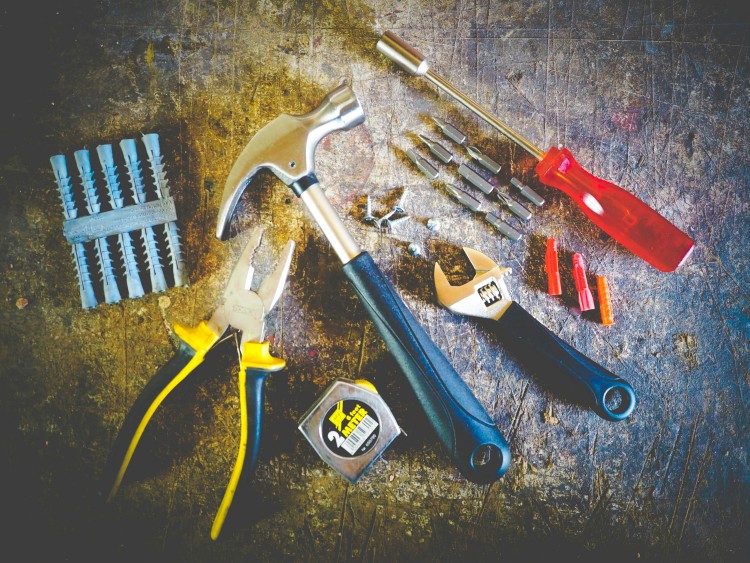You don’t need a garage full of gear to fix most things at home. You need the right few. The secret is the 80/20 rule: about twenty tools will solve roughly eighty percent of the problems you actually face—wobbly shelves, sticky doors, leaky traps, crooked frames, mystery wires, and all the little “I’ll get to it” jobs that linger for months. Build this lean kit once, learn it well, and you’ll stop overbuying, stop overthinking, and start finishing.
Why a lean kit beats a giant toolbox
A giant kit creates friction. You hunt for bits, wonder which blade fits, or discover the battery you need is dead. A lean kit removes those decisions. Every item earns its place by being versatile, durable, and easy to control. The effect is compounding: fewer trips to the store, fewer stalled projects, and far more confidence.
The core philosophy
- Prioritize control over brute force. A 12V drill/driver you can finesse will outperform a monster tool you can’t.
- Standardize sizes. Keep the bits, blades, and fasteners you use most. Eliminate orphans.
- Upgrade only when a pattern demands it. If you’re constantly driving long screws, add an impact driver. If your walls run long, add a laser level. Patterns justify purchases.
The 20
Below is a tight, text-first walk-through of the twenty tools that quietly do almost everything. Each entry explains what it’s for, the moments it shines, and when an upgrade actually makes sense.
1) 12V cordless drill/driver
The everyday engine. Drives screws, bores pilot holes, hangs hardware, installs hinges, and assembles furniture. Two batteries are non-negotiable so you never stall mid-job. If you regularly drive long deck screws or lag bolts, then and only then add an 18V impact driver.
2) Drill and driver bit set
Match the fastener to the job: #2 Phillips, #2 square, T20 Torx cover most of North American hardware. Add high-speed steel bits for wood and thin metals, and one countersink to hide screw heads cleanly. If you cut a lot of metal, step up to cobalt bits.
3) 16 oz claw hammer
Balanced for control. Sets nails without chewing up trim. Light demolition when you need it. If demolition becomes a theme, move to a 20 oz framing hammer.
4) Utility knife with extra blades
Scores drywall, trims shims, opens boxes, scrapes paint. Fresh blades matter more than fancy handles. Snap-off style is ideal for lots of scoring cuts.
5) 25-foot tape measure
Covers rooms, studs, and layouts without running short. Fractions on the blade speed accuracy. Heavy daily use? Choose one with a stiffer standout and add a 12-foot pocket tape for quick jobs.
6) 24-inch bubble level
Trust bubbles over your eyes. Shelves, frames, appliances, and tile lines all depend on it. If you’re laying out long kitchens or gallery walls, consider a self-leveling laser later.
7) Stud finder with AC live-wire detect
Finds framing and warns you about buried electrical. For old plaster walls, buy a multi-sensor model that reads through lath.
8) Ratcheting multi-bit screwdriver
Fast bit swaps and less wrist strain. Keep it close even if your drill is charged. If you do tiny electronics, add a precision set rather than abusing the big driver.
9) Adjustable wrenches (8″ and 10″)
Cover odd nut sizes and supply lines. When you start matching sizes regularly, add combo wrenches in the sizes you touch most rather than a huge set you never use.
10) Slip-joint pliers
General grip for pins, clips, and light crimping. In a pinch, they do a bit of everything until you need more leverage.
11) Needle-nose pliers with cutter
Reach into tight boxes, bend wire, retrieve dropped screws. Electricians live on these for good reason.
12) Groove-joint “channel-lock” pliers (10″)
Your plumbing hero. P-traps, shut-off valves, and stubborn nuts. Pairing two gives you counter-torque without damage.
13) Locking pliers (10″, curved jaw)
When parts are seized, clamp and win. They’re also a third hand during gluing, aligning, or pulling staples.
14) Wire stripper (10–22 AWG)
Clean insulation cuts prevent loose strands and heat. If you’re swapping many outlets and switches, a stripper with integrated looping holes and a deburring reamer saves minutes per box.
15) Non-contact voltage tester
Touch to a wire or outlet and read live vs safe. Test every time before you touch anything electrical. Add a plug-in outlet tester if you do frequent receptacle work.
16) Dripless caulk gun + all-purpose caulk
Seal tubs, backsplashes, trim gaps, and exterior joints. A dripless gun gives clean starts and stops. Long, frequent beads justify a higher-thrust model.
17) Painter’s tape (medium adhesion)
Clean paint lines, safe surface protection, and quick layout marks for hardware and frames. Fresh paint? Use delicate-surface tape.
18) Assorted anchors + screws kit
Keep a labeled box: plastic and toggle anchors for drywall, masonry anchors, and a range of wood screws. Heavy loads like shelves and TV mounts get structural screws or toggles rated for the actual weight.
19) Oscillating multi-tool
Flush cuts, door casing undercuts for flooring, detail sanding, grout removal, and surgical plunge cuts where a saw won’t fit. Variable speed and quick-release heads matter more than raw power. Buy decent blades; cheap ones chatter and burn.
20) Safety glasses + work gloves
Jobs end faster when you don’t have sawdust in your eyes or cuts on your hands. For dusty work, anti-fog glasses pay for themselves. For demolition, choose cut-resistant gloves.
How to use the kit like a pro
- Plan the sequence. Measure, mark, pilot, fasten. Skipping pilots in hardwood splits trim and ruins finishes.
- Trust instruments. Levels and testers beat “looks straight” and “feels off.”
- Secure the work. Clamp when cutting or drilling small parts. It’s faster than fixing mistakes.
- Respect wall types. Drywall, plaster, tile, and brick each need different anchors and bits. Match them.
- Stop when uncertain. Water and electricity punish guesses. Shut off valves and breakers, test, then proceed.
When to expand beyond twenty
Only expand for repeated patterns. Three examples:
- Long, precise layouts: Add a self-leveling laser.
- Regular lumber cuts: Add a compact circular saw or a Japanese pull saw for quiet, clean cuts.
- Dust and wet messes: Add a 5-gallon wet/dry vac with a fine-dust filter.
A quick purchasing map
If you’re stocking from zero, this sequence minimizes trips and gets you productive immediately:
- Drill/driver + two batteries, multi-bit set, utility knife, tape measure, level.
- Stud finder with AC detect, ratcheting driver, slip-joint and needle-nose pliers.
- Groove-joint pliers, adjustable wrenches, locking pliers, wire stripper, voltage tester.
- Caulk gun with all-purpose caulk, painter’s tape, anchors + screws kit, safety glasses and gloves.
- Oscillating multi-tool once you hit a task it solves cleanly.
Conclusion: small kit, big confidence
Most “someday” projects die from tool indecision, not skill. This 80/20 toolbox eliminates that friction. You’ll hang straighter shelves, make cleaner cuts, seal tighter joints, and work safer. Start with the twenty. Learn their feel. Only upgrade when your projects demand it.

